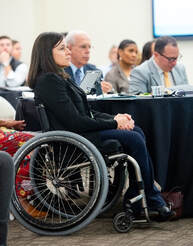Event Recap

On May 20, 2019, PIPC held a briefing on the perils of the quality-adjusted-life-years (QALY) metric and is potential for discrimination against people with disabilities and serious chronic illness. People with disabilities are caught in the middle of the fight over health care costs in America, says PIPC Chairman Tony Coelho, simply because they are the most vulnerable. Speaking at the Coelho Center at Loyola Law School Los Angeles, he told a crowd of disability advocates that unless they stand and fight, interests that scapegoat the wellbeing of people with disabilities will win. At the center of this fight is a measure — the quality-adjusted life year, or QALY. Chairman Coelho was joined by Ari Ne’eman, Collin Killick, and PIPC’s Executive Director, Sara van Geertruyden, to say that the use of QALYs distorts and misrepresents how patients value their own lives, and it can lead to insurers and the government to deny care to people who would benefit from it.
What is the QALY?
The QALY is a tool in therapeutic value assessment. “It is designed to reduce the many different people things that people seek from health care — improvement in quality of life, life extension — to a single number,” explained Mr. Ne’eman. Insurers, researchers, and governments around the globe use the QALY to assess the benefit of different health interventions, often leading to people with disabilities being left out in the cold. For example, said Mr. Ne’eman, under one QALY measure, one “year in a life with moderate multiple sclerosis is worth 54 percent of the year in the life of a hypothetical non-disabled person.”
What does this mean?
This means that “medication or other treatments that are designed to extend the lives of people with disabilities are undervalued,” Mr. Ne’eman told the crowd. It means not just that breakthrough treatments may not be covered, but, as Mr. Killick explained, under a model put forth by New York State that uses QALYs and aggressive tactics for determining which drugs to cover, “you could strip away not just one drug but every drug that the drug’s manufacturer produces.”
What would be better?
Patient voices need to be part of the conversation. Entities like the Institute for Clinical and Economic Review, or ICER, use the QALY to come to determinations about the “value” of a given treatment. “ICER fails to consider people with disabilities,” said Ms. van Geertruyden. In ICER’s studies, she continued, patient input “was incorporated to ICER’s report 15 percent of the time. They should engage with patients and make research patient-centered.”
What is the QALY?
The QALY is a tool in therapeutic value assessment. “It is designed to reduce the many different people things that people seek from health care — improvement in quality of life, life extension — to a single number,” explained Mr. Ne’eman. Insurers, researchers, and governments around the globe use the QALY to assess the benefit of different health interventions, often leading to people with disabilities being left out in the cold. For example, said Mr. Ne’eman, under one QALY measure, one “year in a life with moderate multiple sclerosis is worth 54 percent of the year in the life of a hypothetical non-disabled person.”
What does this mean?
This means that “medication or other treatments that are designed to extend the lives of people with disabilities are undervalued,” Mr. Ne’eman told the crowd. It means not just that breakthrough treatments may not be covered, but, as Mr. Killick explained, under a model put forth by New York State that uses QALYs and aggressive tactics for determining which drugs to cover, “you could strip away not just one drug but every drug that the drug’s manufacturer produces.”
What would be better?
Patient voices need to be part of the conversation. Entities like the Institute for Clinical and Economic Review, or ICER, use the QALY to come to determinations about the “value” of a given treatment. “ICER fails to consider people with disabilities,” said Ms. van Geertruyden. In ICER’s studies, she continued, patient input “was incorporated to ICER’s report 15 percent of the time. They should engage with patients and make research patient-centered.”


